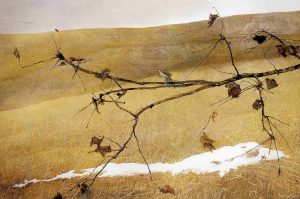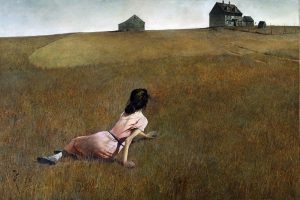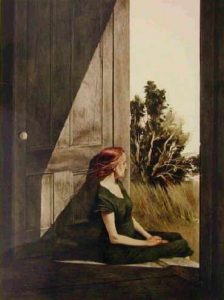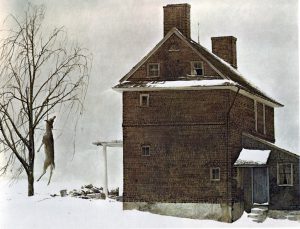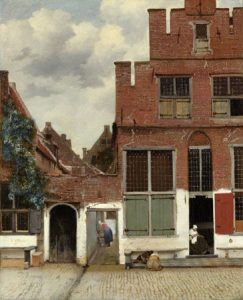EASEL ESSAY: Andrew Wyeth, his Critics, and Small Town Mud
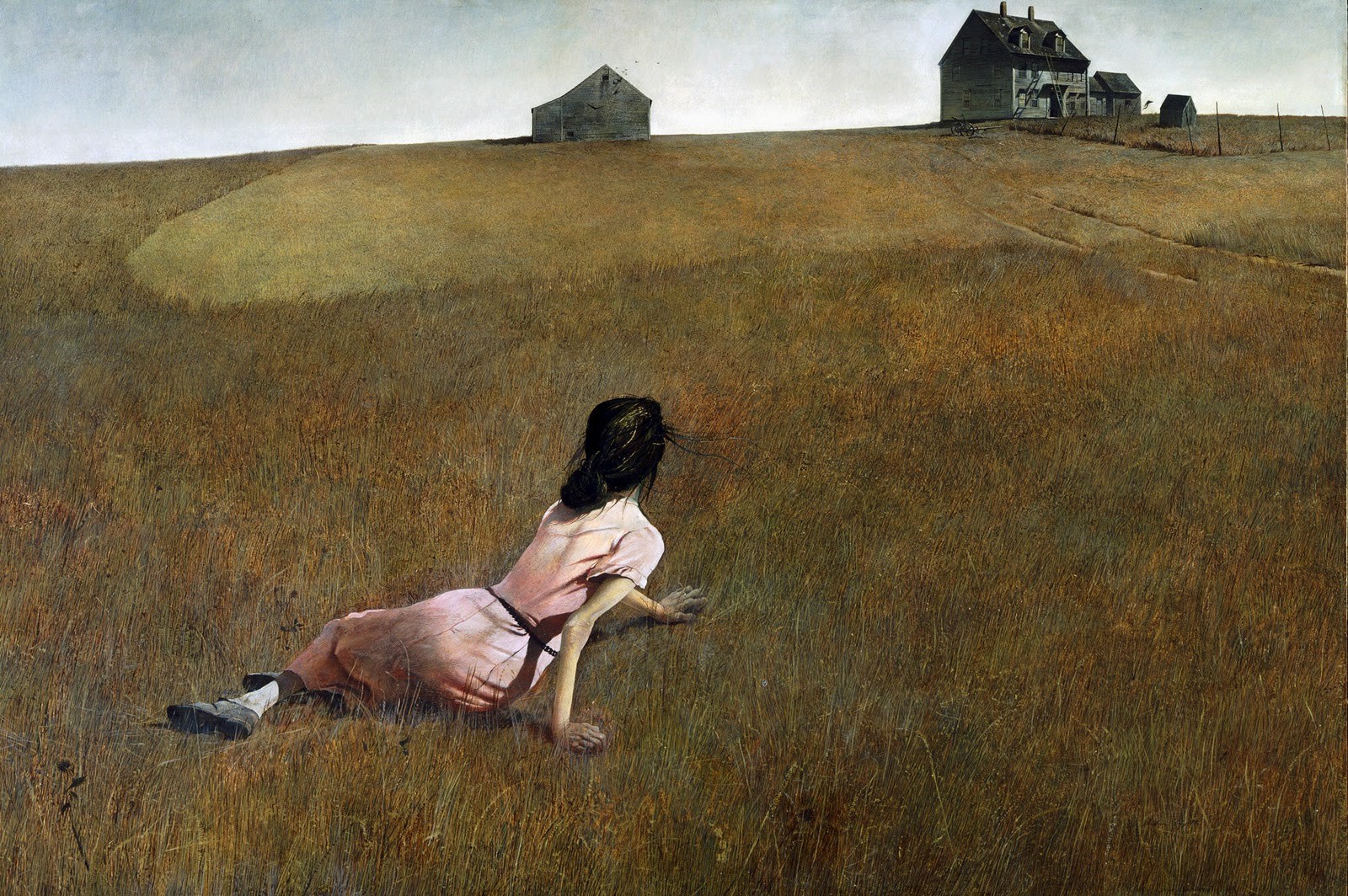
The paintings are of simple things: drapes fluttering in the breeze, a young boy making his way down a hill and across a meadow, ten or fifteen leaves dying on the spindly branch of a tree in late autumn. These images are painted with care, often in tempera, sometimes in watercolor. The attention to detail and the focus on craft evokes some of the great masters of old. Albrecht Dürer comes to mind.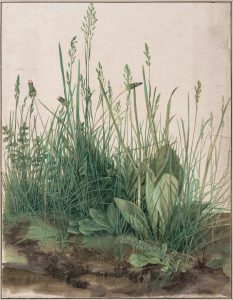 Albrecht Durer The Large Piece of Turf, 1503 watercolour, Albertina
Albrecht Durer The Large Piece of Turf, 1503 watercolour, Albertina
As in Dürer, a tuft of grass becomes the occasion for a display of skill so precise it verges on the ridiculous. Why would anyone in his right mind pay such close attention to the way a single brown stalk of wheat catches the light at the close of an autumn’s day?
Long Limb, 1998 tempera on panel. Private Collect
The almost homely nature of Andrew Wyeth’s pictures, the studiousness with which they avoid big subject matter and big questions would seem to render them unobjectionable to the extreme. And yet, people have objected. They continue to object, sometimes mightily. From the middle of the 20th century—when Wyeth first started to get attention—to his death in 2009, these humble paintings have managed to piss people off. Important people.
So, we have a conundrum. How did a regional painter who lived in, and painted images of, rural Pennsylvania for his entire life (as well as his summer home in Cushing, Maine) become a lightning rod for art world controversy? Why get worked up over paintings that at face value are so very, very polite?
That the sophisticated critics and opinion-makers in places like New York City and London care about Andrew Wyeth is evident from the derision they heap upon him. On the occasion of his death in 2009, for example, Jonathan Jones, the art critic for The Guardian, penned the following lines about the recently departed painter:
Wyeth was the equivalent in art of Bush in politics – retrogressive, short-sighted, and strangely empty and banal. … His vision of an ideal America of hunters and farmers and good country folk was as fanciful and idiotic as the Bush vision of a fortress of good people fighting an endlessly hostile world. His art belongs in retired Republican politicians’ homes, and the boardrooms of bankrupt banks. It does not belong in the Museum of Modern Art. So why is it there?
These sentiments are, by no means, peculiar to Jonathan Jones. A recent article by Daniel Grant in The Observer was titled “Why Do Critics Still Hate Andrew Wyeth?” In the article, Grant catalogued much of this hatred, noting that:
Robert Storr, for a time curator of Contemporary painting and sculpture at New York’s Museum of Modern Art and currently dean of the Yale School of Art, wrote of Wyeth as “our greatest living ‘kitsch-meister.’” Hilton Kramer, art critic at The New York Times and later editor of The New Criterion, complained about Wyeth’s “scatological palette,” which perhaps is a nicer version of critic Dave Hickey’s claim that Wyeth worked in a palette of “mud and baby poop.”
It has, moreover, been pointed out many times and by many critics that Wyeth voted both for Richard Nixon and for Ronald Reagan. There is, clearly, a red state/blue state divide even in the art world. The blue-staters know a red-stater when they see one, and they most certainly see one in Andrew Wyeth. And, to top it all off, Andrew Wyeth has always been popular with the general public. This is a perfect recipe for critical rage.
Going back to the Jonathan Jones piece, it is interesting to note the degree to which this disgust with Wyeth’s politics colors what Jones sees (and doesn’t see) in Wyeth’s paintings. Here, for instance, is what Jones has to say about Wyeth’s famous/notorious painting Christina’s World (1948), which hangs at the Museum of Modern Art in New York City—to Jones’ great displeasure. The painting, Jones declares, is
photographically meticulous, glibly sentimental, and when I encountered the original for the first time in a MoMA exhibit a few years ago I was stunned by its triteness.
Christina’s World, 1948 tempera on panel. Museum of Modern Art, New York
Christina’s World, which everyone has seen (at least in reproductions) hundreds of times, portrays a woman in a pinkish dress sitting on the ground in a field. We see her from the back. Her left arm reaches forward; the other arm is stretched behind her. She looks up toward a wooden farmhouse a few hundred yards away at the crest of a small hill.
The painting is photographically meticulous, as Jones notes, though interestingly, the painting does not look at all like a photograph in person. This is mostly due to Wyeth’s use of tempera, but more on that later. Calling the painting “glibly sentimental” and “trite,” however, requires some interpretation. Jonathan Jones does not say so explicitly, but it is clear from his other comments that Jones sees sentimentality and triteness in the painting’s supposed celebration of “good country folk” and the conservative political and social values that such people hold dear. The woman in the grass becomes, in Jones’ eyes, an idealized portrait of a wholesome rural lass yearning (as all Americans ought to yearn) for the simple life of farming that is, alas, ever fading from the American experience.
There is, however, one small problem with this interpretation. Closer observation of the girl in the field reveals that there is something wrong with her. Christina’s hands don’t rest in the grass; they claw at the earth with animal desperation. And her arms … those skinny, fragile arms. They are the arms of a wraith, not a comely and wholesome farm girl reclining on a summer’s eve. What, moreover, is wrong with her legs, which are tucked behind her with an air of uselessness? Something here is not as it should be.
Christina Olson, 1947 tempera on panel. Curtis Gallery
What’s wrong with Christina (who actually existed and whose full name was Anna Christina Olson) can be seen more clearly in another painting Wyeth made of her in 1947—one year before Christina’s World—and in a number of other later watercolors and portraits. Christina Olson was severely physically disabled. She suffered from a neuro-pathological ailment that robbed her of the use of her legs and caused many of the muscles in the rest of her body to wither. Jonathan Jones notes this (incorrectly calling Christina’s physical condition the result of polio) in his essay. But the fact of Christina’s extreme disability is otherwise of no interest to him.
That’s because Jones has already decided that the painting is trite and simplistic. With that interpretive lens, he stopped looking. But, as the critic Robert Hughes observed, “Art requires the long look.” The more you look at Christina’s World the more mysterious it becomes, both visually and intellectually. What is Christina doing out in that grass? As the critics who hate Andrew Wyeth would have it, she’s out there yearning for the return of Herbert Hoover. In fact, we know from stories Andrew Wyeth has told (and from her own accounts) that Christina Olson was out in the brown grass because that is where she went sometimes. She pulled herself along on the ground, moving around her property by, literally, dragging her withered body and useless legs from one spot to another. One day, Wyeth saw her doing this. He saw her out in the grass moving about like some sort of human-crab. He was so stunned by this image that he knew he had to paint it. This story alone, I would say, paints a rather more complicated picture of “wholesome country life.”
Which isn’t to say that critics who hate Wyeth are entirely wrong. Andrew Wyeth was more interested in country life than in city life. He did vote for Richard Nixon. He did think that the good people of American small towns are, all in all, more authentic. He was both a ‘small c’ and ‘big C’ conservative.
But were his paintings conservative? Is that even an interesting question?
At least we can say the following. Andrew Wyeth focused on small-town Pennsylvania and rural Maine because those were the places about which he truly cared. He cared about them, partly, as a man with conservative values. But this man with conservative small-town values also possessed a rare talent with the brush. Moreover, he had a sensitive and delicate eye. He paid remarkably close attention to the world around him. Images like that of Christina struggling in the grass hit him forcefully. He had the painterly skill to transmute those images onto the canvas.
Something quite interesting happened in that process of transmutation. Looking at the artworks, it ceases to matter why Andrew Wyeth cared about Chadds Ford, Pennsylvania, or Cushing, Maine. What matters more is that places like Chadds Ford are given a space to exist on the canvases that Andrew Wyeth created.
This is a significant task in itself, since it is difficult to bring our experience of the real world into the flat and otherwise-dead world of two-dimensional images. Realist painters have faced this dilemma for hundreds of years. Many of the most important 20th century painters abandoned this struggle as fruitless, or misguided, or as tantamount to a lie. But Wyeth didn’t reject the illusionism at the historical heart of easel painting. He embraced it. Full stop.
Furthermore, by painting his most ambitious works mostly in tempera, Wyeth chose a path that made his realist task supremely difficult. Tempera, which is a quick-drying form of egg-based paint that hasn’t been used much since the early Renaissance, is extraordinarily hard to master.
In a conversation with former Metropolitan Museum of Art Director Thomas Hoving, Wyeth had this to say about why he used tempera:
I think the real reason tempera fascinated me was that I loved the quality of the colors: the earth colors, the terra verde, the ochres, the reds, the Indian reds, and the blue-reds are superb. … There’s nothing artificial. … I love the quality and the feel of it. It’s just fabulous. I like to pick it up and hold it in my fingers. To me, it’s like the dry mud of the Brandywine Valley in certain times of the year or like these tawny fields that one can see outside my windows. … I suppose I really like tempera because it has the cocoon-like feeling of dry lostness—almost a lonely feeling.
Call his palette “baby poop” all you like, but Wyeth found these ochres and reds and terra verdes true to the actual color, and mood, of rural Pennsylvania. In discussing tempera, Wyeth always pointed to the material qualities of the paint, the look and feel of it in his hands, the earthiness of tempera as a substance.
Wyeth liked tempera because he felt that the paint had real-world qualities (“it’s like the dry mud”) that connected the paint, physically, with the subject matter he was trying to paint. The tempera was, for him, just another version of the mud in which grow stalks of wheat and maple trees and scrub grass. There is an ancient intuition here, the intuition that “like knows like,” the magical and alchemical thought that you cannot evoke mud (or what comes of mud) in an image without spreading it physically upon the canvas.
This is where one further suspects that critics like Jonathan Jones aren’t looking very hard at Wyeth’s paintings. To call the paintings “photographic” is to be seduced by the final effect, the shimmering realism of the images that Wyeth coaxed out of his mud and baby poop. But the mud is still very much present as mud; the tempera makes its presence tangible on the canvas. Yes, Wyeth wanted to show us images that we could instantly recognize. But he was also interested in showing us the evidence of the actual work of applying pigment to canvas. He wanted us to see the paint as paint. He liked to leave some trace of his marks and his brushstrokes as he worked.
Look closely, if you will, at the brown grass in the field of Christina’s World. It is best to do so in person, but even a high-resolution picture on the Internet should give you some sense. The paint is a physical reality on the surface of the painting. You can see, in some places, how Wyeth has jabbed and spread and cut at it. This is not true, for instance, of the farmhouse in the distance, which has been smoothed out to the point where the image and the paint have become one. But the grass still bears the scars of Wyeth’s mucking and scraping, his creative labors in dragging the mud into manifestation.
Much, however, as Andrew Wyeth loved the physicality of painting, he was not interested in the physical activity merely for the sake of it. The physical nature of the tempera, its quasi-magical connection to the actual earth of an actual place, was important to Wyeth precisely as a means of drawing something forth from Chadds Ford or Cushing. There is an act of summoning going on here. And the physical act of summoning up a physical place onto a painted canvas also summoned an atmosphere, a sense of what the place is like. So, one minute, Wyeth is rubbing the paint around in his fingers. The next minute, as in the quote above, he is evoking a “cocoon-like feeling,” a “lonely feeling,” and a “dry lostness.” The two acts go hand in hand–the alchemical process of building up pictures from earth and mud creates a finished product that is thick with the mood of country life.
It should further be said that Wyeth did not have a simplistic view of rural and small town life, just as he did not have a simplistic view of tempera. He wasn’t interested in producing bucolic pictures, admitting to Thomas Hoving that “Actually I’m not terribly interested in farming.” Wyeth felt compelled to paint Christina Olson mostly because she was eerie and strange and impossible to understand. He respected the dignity of the woman, an oddity thrown out by nature, a stubborn and wild woman living on a broken-down farm in the middle of nowhere. The mud of Chadds Ford and Cushing causes things to grow, but you never know exactly what you’ll get. Nature swerves in unexpected directions. Life is baffling. Wyeth wanted his tempera paintings to do that too, to swerve out of control, to express the jumps and leaps, the disturbing and the incongruent. For a painting truly to be able to express “mood,” it has to slip out of the artist’s control, at least to some degree. The painting must take on its own logic, become its own world.
The ability to wrest such dynamism from the otherwise inert substance of tempera was, for Wyeth, the result of technical mastery. But he was wary of this mastery too. Wyeth called tempera a “dangerous medium,” dangerous because it “can lead toward [a] cold technical quality, so I think you have to fight this, and I find fighting it a very good thing.” Wyeth loved tempera because it could create such clear and distinct images on the canvas. But he feared it for that very same reason, since life is rarely experienced as clear or distinct.
Tenant Farmer, 1961 tempera on panel. Delaware Art Museum
Take Tenant Farmer from 1961. We’re shown the side of a brick house in the middle of winter. The muddy red-brown of every individual brick on the side of that house is given its full due. I suspect a person could learn how to become a bricklayer just by studying the details of Tenant Farmer. White snow has collected on the steps of the side door. Wyeth shows us those steps, and he shows us how the new-fallen snow has collected on the haphazardly thrown firewood too, just outside the porch at the front of the house.
By his palette, by his tempera, by his specificity, by his attention, Wyeth transmuted the actuality of the tenant farmer’s house onto a flat piece of canvas, a material that otherwise has nothing to do with bricks, or snow, or lonely fields in the woods.
But again, technique is not enough for Wyeth. There is one other crucial element to Wyeth’s snow painting: the dead deer hanging from the rope of a solitary tree. The deer hangs ominously, by the neck, like it has been executed for a crime.
It is the startling image of the deer that best illustrates what Wyeth meant by his fight with tempera, his battle to make sure that the cold, technical quality of the medium not destroy the sense of reality he wanted his paintings to convey. The hanging deer is to Tenant Farmer as Christina’s crab walk is to Christina’s World. On the one hand, there is the house—that massive pile of reddish bricks crying out for all the materiality that tempera can deliver. The bricks want to be given their due, each brick—and there are hundreds of them. Tenant Farmer is as much about bricks as any painting has been about bricks since, I don’t know, Vermeer’s The Little Street.
Johannes Vermeer, The Little Street, c 1657, oil on canvas, Rijksmuseum
But the bricks of Tenant Farmer are merely an inert mass without the hanging deer. The deer brings that disturbing incongruence into the picture, that element of risk. It’s as if the hung deer and the brick house need one another. Together, they become complementary components of the undeniable reality that Wyeth wants to show us in this winter scene. The physicality of the tempera evokes the real (if superficial) earthiness of country life; the deer unsettles it.
Looking at Tenant Farmer, one feels the mood of Wallace Stevens’ great poem of the snow, The Snow Man.
One must have a mind of winter
To regard the frost and the boughs
Of the pine-trees crusted with snow;
And have been cold a long time
To behold the junipers shagged with ice,
The spruces rough in the distant glitter
Of the January sun; and not to think
Of any misery in the sound of the wind,
In the sound of a few leaves,
Which is the sound of the land
Full of the same wind
That is blowing in the same bare place
For the listener, who listens in the snow,
And, nothing himself, beholds
Nothing that is not there and the nothing that is.
In this poem, Stevens played around with language, with words and grammar and punctuation, such that the poem actually becomes the “mind of winter” and creates that same mind in the person who reads it. Isn’t this more or less what Wyeth was doing in his fight-to-the-death with tempera, in his attempt to get the cold technicality of the medium to evoke a real world, a real place like Chadds Ford? I propose that it is impossible to look at Tenant Farmer in good faith and not to be swept into the “mind of winter” as it exists in rural Pennsylvania, on the lonely farms that dot the rolling landscapes of America and from which still, to this day, thin streams of smoke can be observed drifting up from the chimneys into the brittle air of a January morning. I propose that it is similarly impossible to look at Tenant Farmer in good faith and not to understand, in a flash of comprehension, what Wyeth meant by claiming that the substance of tempera, in the right hands, is capable of creating a “cocoon-like feeling of dry lostness.” I propose, finally, that it is impossible to look, really to look at Tenant Farmer—or Christina’s World—and not to acknowledge that the world Wyeth has called forth with his act of sorcery by means of tempera, this unfathomable world, is anything but trite.
Wyeth Images: © 2016 Andrew Wyeth / Artists Rights Society (ARS), New York

